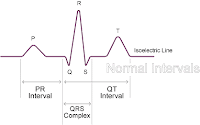 |
The ST segment measures the time from the end of ventricular depolarization to the start of ventricular repolarization. The ST segment is the straight line connecting the end of the QRS complex with the beginning of the T wave.
The QT interval measures the time from the beginning of ventricular depolarization to the end of ventricular repolarization. The QT interval includes the QRS complex, the ST segment, and the Twave.
Why are these intervals and segments important? Please take time to review some of the videos provided in the blog header to understand these important elements of an EKG. Please review the following site for more info.
http://www.nottingham.ac.uk/nursing/practice/resources/cardiology/function/normal_duration.php

